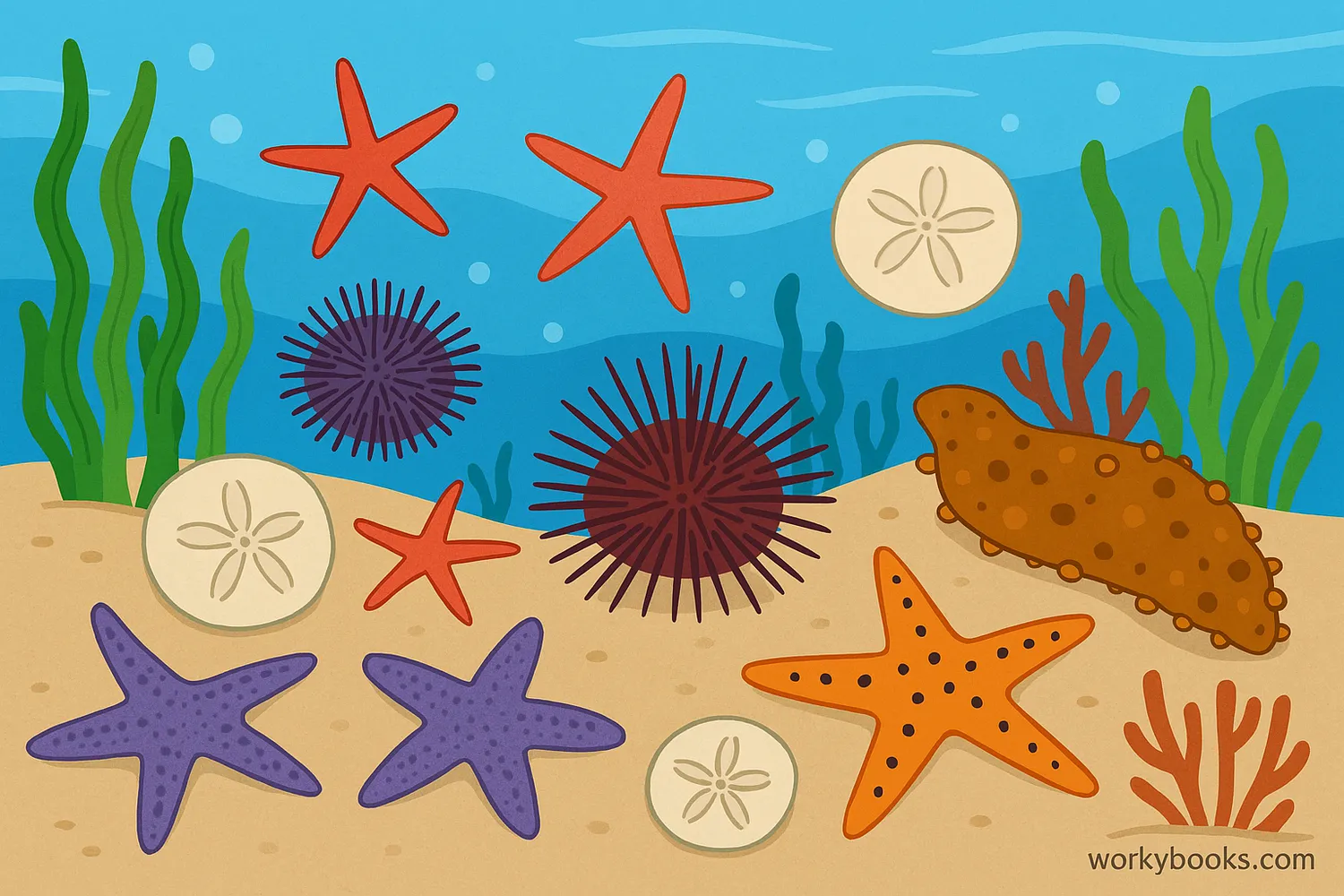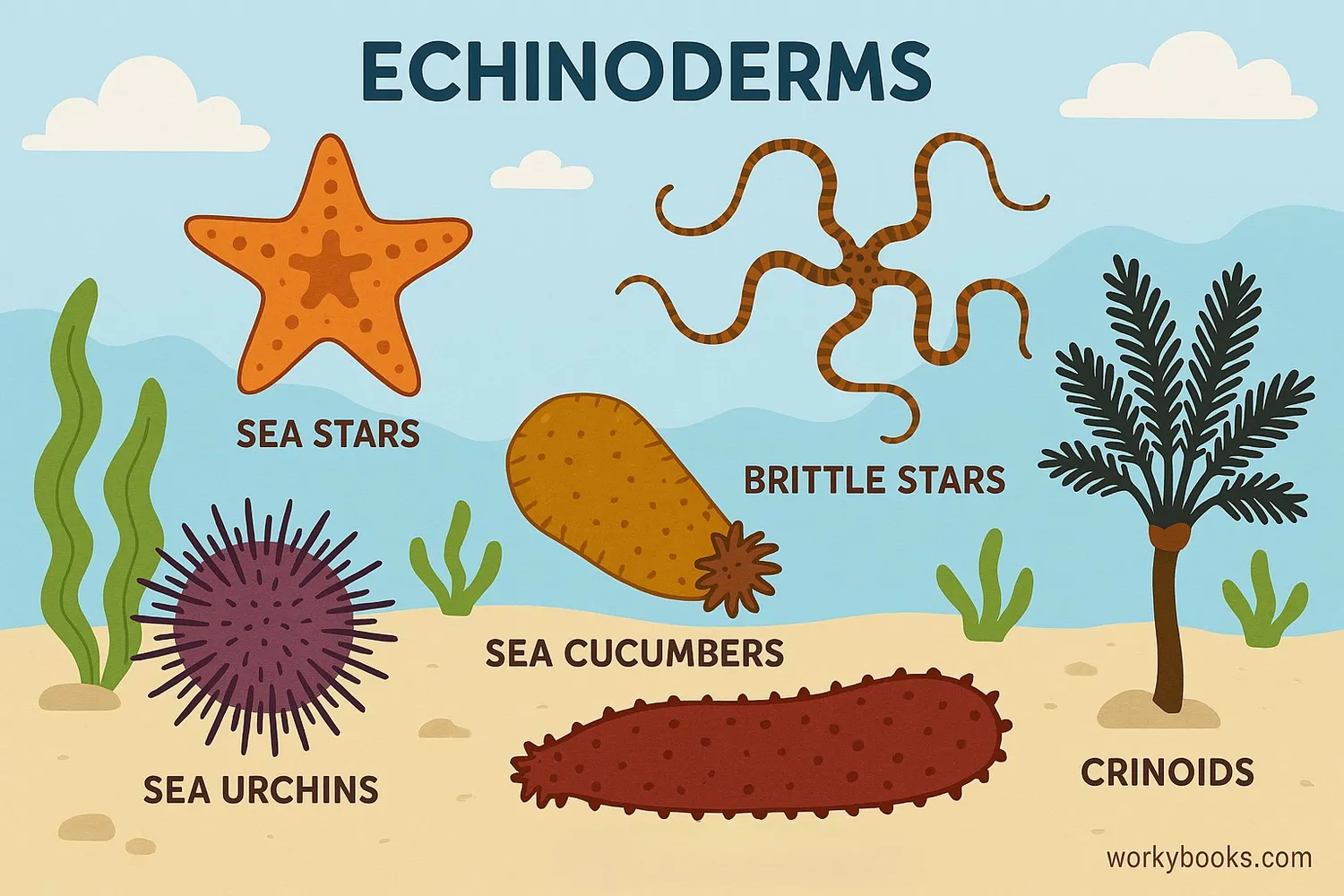Echinoderms - Definition, Examples, Quiz, FAQ, Trivia
Discover the amazing world of spiny-skinned marine animals!
What Are Echinoderms?

Echinoderms are a group of marine animals with spiny skin! The name "echinoderm" comes from Greek words meaning "spiny skin." These fascinating creatures live only in ocean environments, from shallow tide pools to the deepest parts of the sea.
Echinoderms include familiar ocean animals like sea stars (starfish), sea urchins, sand dollars, and sea cucumbers. They have been around for more than 500 million years, with fossil evidence showing they've changed very little over time.
What makes echinoderms special is their radial symmetry - their body parts are arranged in five equal sections around a central point, like the spokes of a wheel. They also have a unique water vascular system that helps them move and feed.
Did You Know?
There are about 7,000 known species of echinoderms, and scientists believe there may be many more yet to be discovered in the deep ocean!
Key Characteristics of Echinoderms
Echinoderms have several special features that make them unique in the animal kingdom. Here are their key characteristics:
Radial Symmetry
Body parts arranged in five equal sections around a central point
Spiny Skin
Hard plates or spines made of calcium carbonate under their skin
Water Vascular System
Network of water-filled canals that power their tube feet
Tube Feet
Small, suction-cup like structures used for movement and feeding
Regeneration
Ability to regrow lost arms or body parts
One of the most amazing things about echinoderms is their water vascular system. This network of water-filled canals connects to their tube feet. By changing water pressure in different parts of this system, they can extend or retract their tube feet to move around or grab onto surfaces.
Echinoderms also have the incredible ability to regenerate lost body parts. Some sea stars can regrow an entire arm if it gets damaged or detached. In fact, a few species can even regenerate a whole new sea star from just a single arm!
Marine Marvels
Echinoderms don't have blood like we do! Instead, they use seawater in their water vascular system to transport nutrients and oxygen throughout their bodies.
Types and Examples of Echinoderms

Scientists classify echinoderms into five main groups. Each group has unique features and adaptations for their ocean environment:
Sea Stars
Also called starfish, usually with 5 arms but some species have more
Brittle Stars
Long, flexible arms that break off easily as a defense mechanism
Sea Urchins
Round bodies covered with movable spines for protection
Sea Cucumbers
Soft-bodied animals that look like vegetables crawling on the ocean floor
Crinoids
Feather-like arms that filter food from water; some are attached to the ocean floor
Each type of echinoderm has adapted to its specific habitat in the ocean:
• Sea stars are predators that prey on mollusks like clams and oysters
• Sea urchins use their sharp spines for protection and their special mouthparts to scrape algae off rocks
• Sand dollars are flat, burrowing animals that live partially buried in sandy ocean floors
• Sea cucumbers help clean the ocean floor by eating decaying matter
• Brittle stars are often found hiding in coral reefs or under rocks
These amazing animals play important roles in marine ecosystems around the world!
Echinoderm Knowledge Quiz
Test what you've learned about echinoderms with this quiz! Answer all 5 questions to check your understanding.
Frequently Asked Questions
Here are answers to some common questions about echinoderms:
Fascinating Echinoderm Facts
Discover some amazing facts about echinoderms!
Amazing Regeneration
Some sea stars can regenerate a complete new body from just a single arm! This process can take several months to a year to complete.
Clever Defense
Brittle stars get their name from their defense mechanism - their arms break off easily when grabbed by predators, allowing them to escape while the predator is distracted by the wriggling arm.
Deep Sea Dwellers
Some sea cucumbers live in the deepest parts of the ocean, more than 5 miles below the surface! These deep-sea species have adapted to extreme pressure and darkness.
Ancient Animals
Echinoderms have existed for over 500 million years! Fossil evidence shows they've changed very little, making them living fossils that help scientists understand ancient marine ecosystems.


